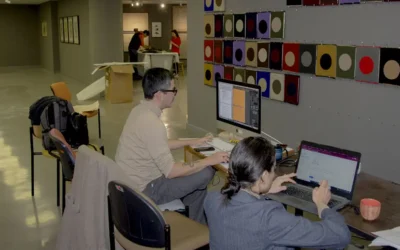Myth #1: You Should Digitize All the (Museum) Things!

Rachael Cristine Woody
We’ve all been there. Politely fielding well-intentioned suggestions to digitize the entire museum collection from board members, donors, researchers, and other museum enthusiasts.
If people haven’t digitized collection items, it’s understandable that they’re not aware of the intricacies, time, cost, and implications of digitizing collection items, let alone a whole collection. But, as a collection worker, it’s frustrating to repeatedly hear misguided suggestions to digitize an entire collection. There are five digitization myths in total, and it’s time to dispel them for our stakeholders. The first myth is that we can or should digitize the entire museum collection. This myth can come with the addition of “…and put it online!”. Let’s break this myth down and, at the very least, have this post to refer to when we receive the next audacious suggestion.
Myth #1: You should digitize the entire museum collection and put it online!
Honor the Intention
First, it’s important to remember that this suggestion is coming from a good place. Whomever is doing the suggesting is doing so because they:
- Love the collection;
- Want to see it preserved digitally; and/or
- Want everyone to have easier access to the collection via its digital files (usually online).
But if they’ve never engaged in a mass digitization project before, then they don’t have an understanding of the work involved. Additionally, they’re even less likely to be aware of the variety of reasons that may lead museum professionals to choose NOT to digitize.
Engage with the Suggestion and Provide Context
When these suggestions are given, I encourage you to engage with the person in conversation. In doing so, you’re respecting their suggestion by your sincere engagement with it. This also opens the person up to learning more about what their suggestion would entail. For example:
Donor: Why don’t you digitize the whole collection and put it online?
You: I wish we could! Digitizing items from the collection and providing them online is a great way to deliver value to our audience. However, it’s also really expensive. Did you know that for every item we digitize and catalog online, it takes an average of 45-minutes?
Donor: *Astonishment*
You: Right?! To go from museum item to online there are a series of steps, and each take “X” amount of time. When it’s all said and done, that’s the average amount of time per item. We also may not have the right equipment to digitize certain objects, some may be too fragile to be digitized, there may be privacy or cultural sensitivity issues as to why we would choose not to digitize an item, etc. As you can see, there are a lot of things to consider including staff capacity.
End scene.
We Have Our Reasons – Put Them into Policy.
As indicated in the mock conversation above, there are several reasons why a collection worker will choose not to digitize an item. Listing them out somewhere in the form of a digitization policy may prove useful for operations, grant applications, and when suggestions like these come up.
Here’s an example:
The {Insert Name} Museum may choose not to digitize items from the collection, nor put them online if one or more of the following conditions are present:
- The museum doesn’t own the item.
- The item is too fragile to undergo excess handling and/or the digitization process.
- There’s personally identifiable information on the item.
- It would be culturally insensitive to digitize the item or put it online.
- The museum doesn’t possess or have access to the appropriate digitization equipment.
- The museum doesn’t have staff available who are trained in the necessary areas to perform this work according to best practices.
As you can see, there are matters of ownership, copyright, preservation, confidentiality, and cultural sensitivity to consider. This is in addition to needing access to the appropriate types of digitization equipment, and staff who have the right expertise as well as the availability to do the work.
Conclusion
By engaging in discussion, providing education around what it takes, and formalizing policy, we can help to alleviate the number of requests we receive to “Digitize all the things!”. Additionally, by dispelling this myth we can correct expectations, create opportunities for fundraising, advocate for the tools and staff we need, and strengthen our ability to digitize collection items the right way.
Additional Reading
Myth #2: It’s Easy to Digitize Museum Collections
Myth #3: It’s too Hard to Digitize Museum Collections

Rachael Cristine Woody
Rachael Cristine Woody advises on museum strategies, digital museums, collections management, and grant writing for a wide variety of clients. In addition to several titles published by Lucidea Press, she is a regular contributor to the Think Clearly blog and an always popular presenter. And remember to check out Lucidea’s Argus solution for powerful and innovative museum collections management.
Never miss another post. Subscribe today!
Similar Posts
How to Incorporate Interns in Museum CMS Projects: Data Creation
A museum expert details how interns can be successfully included in museum CMS projects at the data creation stage.
How to Incorporate Interns in Museum CMS Projects: Data Capture
A museum expert highlights how interns can be included in museum CMS projects at the data capture stage
How to Incorporate Interns in Museum CMS Projects
A museum expert highlights how interns can be included in museum CMS projects with three project ideas.
Create a Start-to-Finish Process for Cataloging Objects in the Museum CMS
A museum expert outlines the start-to-finish process for cataloging objects into a new museum CMS.
Hosting service
Enjoy all of the benefits of your Lucidea solution with secure, reliable, stress free hosting
Programs & incentives
No matter your size or budget, we’ve got you covered, today and tomorrow




Leave a Comment
Comments are reviewed and must adhere to our comments policy.
0 Comments